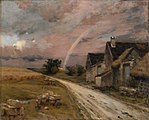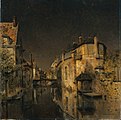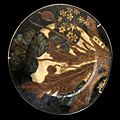Jean-Charles Cazin
Jean-Charles Cazin (born May 25, 1841 in Samer ; died March 26, 1901 in Le Lavandou ) was a French ceramist, painter, engraver and draftsman.
Life
Jean-Charles Cazin was the son of the doctor François-Joseph Cazin, his brother Henri Cazin also became a doctor. He grew up in Samer and Boulogne-sur-Mer . In 1862 he attended the painting school of Horace Lecoq de Boisbaudran in Paris and in 1863 exhibited the picture Souvenir de dunes à Wissant in the Salon des Refusés . From 1863 to 1868 he worked as a drawing teacher at the École spéciale de dessin d'architecture by Émile Trélat . In 1868 he married the painter and sculptor Guillet Marie Cazin (1844-1924) and from 1869 he worked as a curator at the Musée des beaux-arts de Tours and in the city as the director of the art school. After the Franco-Prussian War, they moved to England in 1872 to open an art school with Alphonse Legros , but they did not succeed. Instead, he decorated numerous ceramics for the Fulham Pottery in London . Later he created numerous ceramics together with his son.
In 1874 he returned to Paris and in 1876 exhibited the picture The Shipyard in the Salon de Paris . He settled in Boulogne-sur-Mer and painted historical genre paintings and biblical scenes that met with incomprehension. Therefore, he concentrated on the landscape on the Pas de Calais . In the Paris Panthéon he completed wall paintings that Puvis de Chavannes had started there. In 1885 he was the model for his friend Auguste Rodin for his sculpture Die Bürger von Calais , Rodin took him for the figure of Eustache de Saint-Pierre. In 1893 he traveled with his son, the engraver, medalist and ceramist Michel Cazin (1869–1917), with 180 pictures to the USA, where he was warmly received and won Henry Clay Frick as a collector.
Cazin was inducted into the Legion of Honor in 1882 and made an officer in 1889. The "Musée Jean-Charles-Cazin" was set up in his birthplace Samer with pictures, ceramics and medals by Cazin, his wife, his son and his daughter-in-law Berthe Cazin (1872–1971).
- photos
literature
- GP Weisberg: Cazin, Jean-Charles . In: General Artist Lexicon . The visual artists of all times and peoples (AKL). Volume 17, Saur, Munich a. a. 1997, ISBN 3-598-22757-4 , p. 417 f.
Web links
- Jean-Charles Cazin at Google Arts & Culture
- Literature by and about Jean-Charles Cazin in the WorldCat bibliographic database
| personal data | |
|---|---|
| SURNAME | Cazin, Jean-Charles |
| BRIEF DESCRIPTION | French ceramist, painter, engraver and draftsman |
| DATE OF BIRTH | May 25, 1841 |
| PLACE OF BIRTH | Samer |
| DATE OF DEATH | March 26, 1901 |
| Place of death | Le Lavandou |








